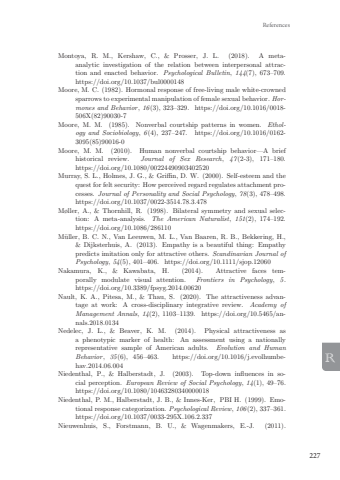Page 229 - Demo
P. 229
227ReferencesRMontoya, R. M., Kershaw, C., & Prosser, J. L. (2018). A metaanalytic investigation of the relation between interpersonal attraction and enacted behavior. Psychological Bulletin, 144(7), 673–709.https://doi.org/10.1037/bul0000148Moore, M. C. (1982). Hormonal response of free-living male white-crownedsparrows to experimental manipulation of female sexual behavior. Hormones and Behavior, 16(3), 323–329. https://doi.org/10.1016/0018-506X(82)90030-7Moore, M. M. (1985). Nonverbal courtship patterns in women. Ethology and Sociobiology, 6(4), 237–247. https://doi.org/10.1016/0162-3095(85)90016-0Moore, M. M. (2010). Human nonverbal courtship behavior—A briefhistorical review. Journal of Sex Research, 47 (2-3), 171–180.https://doi.org/10.1080/00224490903402520Murray, S. L., Holmes, J. G., & Griffin, D. W. (2000). Self-esteem and thequest for felt security: How perceived regard regulates attachment processes. Journal of Personality and Social Psychology, 78(3), 478–498.https://doi.org/10.1037/0022-3514.78.3.478Møller, A., & Thornhill, R. (1998). Bilateral symmetry and sexual selection: A meta‐analysis. The American Naturalist, 151(2), 174–192.https://doi.org/10.1086/286110Müller, B. C. N., Van Leeuwen, M. L., Van Baaren, R. B., Bekkering, H.,& Dijksterhuis, A. (2013). Empathy is a beautiful thing: Empathypredicts imitation only for attractive others. Scandinavian Journal ofPsychology, 54(5), 401–406. https://doi.org/10.1111/sjop.12060Nakamura, K., & Kawabata, H. (2014). Attractive faces temporally modulate visual attention. Frontiers in Psychology, 5.https://doi.org/10.3389/fpsyg.2014.00620Nault, K. A., Pitesa, M., & Thau, S. (2020). The attractiveness advantage at work: A cross-disciplinary integrative review. Academy ofManagement Annals, 14(2), 1103–1139. https://doi.org/10.5465/annals.2018.0134Nedelec, J. L., & Beaver, K. M. (2014). Physical attractiveness asa phenotypic marker of health: An assessment using a nationallyrepresentative sample of American adults. Evolution and HumanBehavior, 35(6), 456–463. https://doi.org/10.1016/j.evolhumbehav.2014.06.004Niedenthal, P., & Halberstadt, J. (2003). Top-down influences in social perception. European Review of Social Psychology, 14(1), 49–76.https://doi.org/10.1080/10463280340000018Niedenthal, P. M., Halberstadt, J. B., & Innes-Ker, �PBI H. (1999). Emotional response categorization. Psychological Review, 106(2), 337–361.https://doi.org/10.1037/0033-295X.106.2.337Nieuwenhuis, S., Forstmann, B. U., & Wagenmakers, E.-J. (2011).Iliana Samara 17x24.indd 227 08-04-2024 16:37


